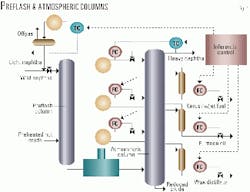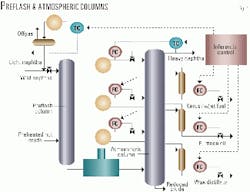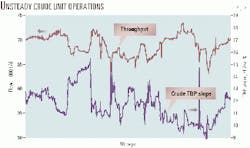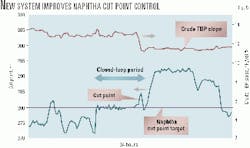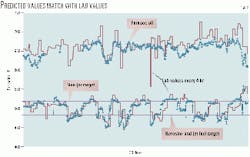Installation of an online closed-loop system resulted in dramatic improvements of product qualities for a crude unit at a Pennsylvania refinery.
With the new system installed, product qualities from the unit have much less scatter and the unit have better control of its reflux system. The new system significantly reduces crude switchover times while maintaining product qualities on target. It has also reduced operator loads.
United Refining Corp.'s 65,000 b/d refinery in Warren, Pa., used two programs to implement inferential technology in its new online system: GCC (generalized cut point controller) and CPPM (crude plant-performance monitor). The system controls product qualities and internal reflux of the refinery's preflash and atmospheric columns.
United Refining implemented the new system in response to its varied product quality from crude fractionation. Changing crudes and operating conditions made online measurements of crude properties costly and unreliable. Offline lab measurements, another alternative, were not timely enough to help operators keep the qualities on target.
Process operations
Fig. 1 is a schematic of the two columns at the Warren refinery.
The crude, after preheat, enters the preflash column at 320 degrees F. A small amount of additional feed, wild naphtha of varying composition, enters the top tray of the preflash column with the reflux. The reflux controls the top-tray temperature, and hence controls the heavy-tail composition of the light naphtha product. A small offgas stream leaves the overhead receiver.
The bottoms of the preflash column flows to the atmospheric heater, where it is heated to 700 degrees F. before entering the flash zone of the atmospheric column. The top product is heavy naphtha, whose heavy-tail composition is controlled by a reflux and top-pumparound.
Side-strippers use steam to strip three side products: kerosine or jet fuel, furnace oil, and wax oil. The reduced crude goes directly to the vacuum heater. Two additional pumparounds control heat removal and internal reflux.
Regular operations of the column present several noteworthy problems:
- The crude flow and composition vary significantly, as shown in Fig. 2. Main switches of crude occur almost daily. The crude is also often not uniformly blended.
- Although lab analyses of products are done every 4 hr, a common frequency, varying crude composition makes it difficult for the operator to interpret past lab results for current conditions. This is particularly true if a sample was pulled just prior to or during a crude switch.
- The composition and flow of the wild naphtha is variable and not well-known, compromising control of the light naphtha tail end.
- Draw-off trays in the kerosine and furnace-oil sections of the atmospheric column often run dry, as a result of tray leakage or weeping.
- Measuring instruments of the atmospheric-column reflux and the upper and middle circulating refluxes often bump up against process constraints.
Before implementation of inferential control, these difficulties caused the quality of products to vary widely from the desired specifications.
Fig. 3 shows typical 90% ASTM distillations of heavy naphtha, kerosine, and furnace oil during 1 month of operation in 2000, prior to installing the new control system. The temperature spreads in these figures exceed 50 degrees F., well outside the desired range of desirable product qualities.
Although some of this variation is a result of changes in product specifications, much of the variation was a result of the inability to control temperature.
Project overview
The main objective of the new online control system was to improve product-quality control. In particular, United Refining wanted better control of its columns and product qualities during crude switchovers.
Another objective was to improve control of pumparound-heat removal, hence improving control of the internal reflux of the atmospheric column.
To achieve these objectives, the new control project used inferential technology, which included:
- Use of temperature profiles, pressures, product flows, and other process measurements of the two columns to construct the true boiling point (TBP) of the crude being fed to the unit.
- Prediction of product qualities and vapor-liquid (V-L) profiles based on the constructed TBP of the crude and on overall heat balances.
- Calculation of set points of sidestream and pumparound flows to achieve desired product qualities and reasonable internal reflux.
The plant installed two main programs, GCC and CPPM, which work side-by-side, to implement the inferential technology. GCC is a generalized cut point controller, provided by PetroControl, New York, and CPPM is a crude plant performance monitor, a product of Kesler Engineering Inc., Brunswick, NJ.
GCC is a compact, integrated package of constraints, dynamics, manipulated variables, and inferential models.1
To increase its speed and simplicity, GCC takes into account a finite set of instrument measurements with no redundancy. If one of these measurements are erroneous, GCC results could be inaccurate.
CPPM uses a rigorous, proprietary tray-to-tray model and redundant measurements that enhance its accuracy.2 It periodically updates selected parameters to correct GCC biases.
Combining CPPM's rigorous solution with the speed of response and robustness of GCC results in superior prediction of inferred product properties.
GCC and CPPM, are integrated with Plant Information System (PI), a product of OSI Software Inc., San Leandro, Calif., to retrieve online data and store results in real time. Set point values that GCC stores in PI are relayed, via an interface, to a distributed control system (DCS) for closed-loop control of selected manipulated variables.
In addition to its control functions, the plant uses PI for performance monitoring of the application. This PI is a dedicated, local system.
GCC
GCC performs three functions:
- It constructs a crude TBP using heat balances, conversions of equilibrium-flash vaporization (EFV) to TBP values, and semirigorous engineering techniques. GCC calculates the portion of the crude vaporized at two anchor points: the column flash-zone and the top-tray overhead. It assumes a linear slope for the crude TBP between the two anchor points.
To calculate the TBP of the crude at the flash zone, GCC considers the temperature of the flash zone, corrected for partial pressure, to be the EFV end point (dew point) of the vaporized portion of the crude. It uses API data book procedures3 to convert the EFV to TBP values.
Further, GCC uses a heat balance to calculate the portion of the crude vaporized, rather than obtaining it from the sum of the products. This approach is more accurate, particularly during unsteady operations following crude switchovers, because a shock resulting from changes in mass flow (for example, as a result of a lighter crude) can be masked by tray and vessel hold-ups, while changes in heat flux cannot be hidden and are immediately detected by a heat balance.
GCC calculates the TBP of the lower-boiling anchor of the crude in a similar fashion. It considers the top-tray temperature, corrected for partial pressure, to be the EFV of the end point of that vaporized portion of the crude, namely, of the heavy naphtha.
GCC then, constructs the TBP curve of the crude. Generally, it considers the sidestream draw temperatures to determine the degree of nonlinearity in the curve. For this project, given the better steady-state results of CPPM, GCC assumes the TBP profile of the crude between the two anchor points to be linear.
- It predicts product properties and V-L profiles. Having established a TBP profile, GCC calculates product flows from heat balances around each sidestream section, and product cut points from the crude TBP vs. volume recovered. It uses API procedures to convert the TBP distillation values to ASTM distillation values and uses short-cut methods to correct tail-end ASTMs for internal reflux.
It calculates internal reflux from an overall heat balance around the appropriate column section.
- It calculates set points of product flows required to meet quality specs and of pumparound flows to provide reasonable internal reflux. GCC calculates online set point values of key manipulated variables to their respective control loops and stores them in PI. A customized interface transmits the values from PI to DCS. These values ensure on-spec product yields and reasonable internal V-L profiles.
GCC performs the above functions about once every minute. Its speed and robustness are due, in part, to the short-cut methods that it uses. GCC calibrates the correlations and the model that it generates with several sets of historic data.
CPPM complements GCC by providing a more rigorous basis for tuning key parameters of GCC, about once every 10 min.
An important aspect of the online implementation is to ensure validity and reasonableness of the plant data obtained from PI. GCC includes data conditioning procedures to check the data and to identify outliers and faulty instrumentation.
CPPM
CPPM is a rigorous tray-to-tray model of two columns. The tray-to-tray calculations use open-equation formulation with proprietary procedures of lumping components and trays to enhance solution and robustness.
The model used several historic data sets for calibration to establish tray efficiencies in the various sections of the columns. The solver/optimizer incorporates the calibrated model. The solver/optimizer retrieves temperature profiles and product flows from PI and interactively constructs a crude TBP by minimizing errors between calculated and measured values.
CPPM uses redundant measurements to construct the crude TBP. Should a measurement be erroneous, CPPM can detect and disregard the measurement. Once reconciliation is achieved, the tool calculates product ASTM distillation points, V-L profiles, and other column parameters.
Having established the composition of the crude, CPPM predicts, with the tray-to-tray model, 90% ASTM distillations of the key products and V-L profiles for the given set of pumparound duties. It stores the calculated values in PI. CPPM also calculates and stores in PI updated parameters for GCC.
Fig. 4 presents an overview of the system. The figure shows two blocks essential for online, closed loop operations: data conditioning and checking results.
CPPM includes statistical tests and heuristics to eliminate inconsistent or suspect data. It also checks to ensure the column has reached a reasonable steady state of operations. Similarly, CPPM checks reasonableness and consistency of results, limiting changes to a certain percentage of proceeding values. These "filters" have improved performance and conformity of the predicted qualities with lab measurements.
Benefits
Fig. 5 shows an example of dramatically improved control of heavy naphtha 90% ASTM distillations at a closed-loop operation during a 5-hr period vs. in an open-loop operation.
Fig. 6 shows closed-loop control of 90% ASTM distillations of kerosine and jet fuel and furnace oil vs. lab data. The system predicts values that match well with lab measurements.
With use of the new tools, product qualities of 90% ASTM distillations are significantly closer to desired specs and have a much narrower scatter than those recorded before installing the system (compare with Fig. 3).
Other benefits of the project include:
- Maintaining product qualities during crude switchovers.
- Better control of internal reflux, reducing the frequency of side-stripper level loss events.
- Higher pumparound recovery as a result of better internal-reflux control.
- Reduction of operator loads.
In terms of operator acceptance, following training and a period of the system working in open loop, closing the quality-control loop was relatively trouble-free. The application quickly gained popularity as a result of its ability to handle crude switches and side-stripper level loss incidents.
References
- Friedman, Y.Z., "Model-Based Control of Crude Product Qualities," Hydrocarbon Processing, Feb. 1994, pp. 96-106.
- Kesler, M.G., et al., "New Method Dynamically Models Hydrocarbon Fractionation," Hydrocarbon Processing, Oct. 1995, pp. 93-100.
- "Petroleum Refining," Chap. 3, API Technical Data Book, Mar. 1988.
The authors
Mark Schuler is a control systems engineer at United Refining Co.'s Warren, Pa., refinery. He is responsible for implementing and maintaining advanced process control applications and other process control related work. Previously, he worked for Saudi Aramco as a control systems planning engineer, for Statoil AS as an offshore process engineer, and for Conoco Inc. as a refinery process design engineer. Schuler holds a BS in chemical engineering from the University of Colorado at Boulder.
Y. Zak Friedman is a principal consultant in advanced process control and online optimization with Petrocontrol. He specializes in the use of first-principle models for inferential process control, and has developed a number of distillation and reactor models. Friedman's experience spans 30 years in the hydrocarbon industry, working with Exxon Research & Engineering and KBC Advanced Technology. He holds a BS from the Israel Institute of Technology (Technion), Haifa, and a PhD from Purdue University, West Lafayette, Ind.
Michael G. Kesler is founder and president of Kesler Engineering Inc., which specializes in software development and applications for the petroleum and petrochemical industries. He has spent over 40 years in the design, modeling, optimization, and thermodynamics of hydrocarbon processes. He holds BS and MS degrees from the Massachusetts Institute of Technology, Cambridge, and a PhD from New York University, all in chemical engineering.
Paul Belanger was a lead engineer at Kesler Engineering Inc. at the time this project was done. He participated in the development of algorithms and software for the inferential fractionator control described in this article as well as the development of other engineering software tools offered by Kesler Engineering Inc. Belanger holds a PhD in chemical engineering from Lehigh University in Bethlehem, Pa., and is currently employed by Praxair Inc.
Based on a paper presented at the NPRA 2000 Computer Conference, Chicago, Nov. 13-15, 2000.
